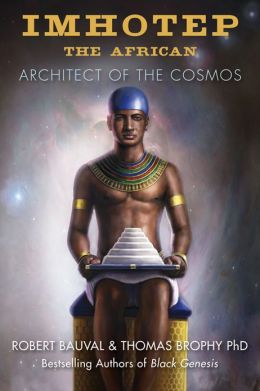Get past the mental image of trudging zombies chanting, “Im-ho-tep, Im-ho-tep...” from the 2006 film The Mummy starring Brendan Frasier and Rachel Weisz. Imhotep was the chief architect, master mason and star observer for an early pharaoh, King Netjerykhet-Djoser. Djoser was the founder of the 3rd Dynasty and ruled from approximately 2690 to 2660 BCE. The authors gather archeological, astronomical, and literary clues to solidify the identity of this king, and the sources of Imhotep's command of astronomy and hewn-stone construction.
The trail of evidence leads into prehistoric times. The authors use satellite imagery and astronomy software to analyze the Nabta Playa site. They credit the Neolithic-Holocene inhabitants of Nabta Playa with using megaliths to mark star sightings from 6100 to 3800 BCE. Further evidence ties the Neolithic herders of south-western Egypt to the early civilization of the Egypt Nile. The astronomical knowledge of these early herders became the basis of the stellar reincarnation cult associated with Osiris and Horus. The stellar implications of mummification procedures are discussed in detail.
Imhotep is credited with designing and building the Step Pyramid complex at Saqqara. The astronomical orientation and purpose of the building are discussed at length, along with the sacred numerology integrated into the design of the surrounding walls. The astronomical associations of two ancient rituals, the Stretching of the Cord and the Opening of the Mouth, are examined. Imhotep's tomb has yet to be found. If it is located, the information given here may be subject to revision. The end of the book offers four appendices, a bibliography, and end notes.
The reader should be prepared to wade through a protracted academic pissing contest. Too many Egyptologists have based their life's work on erroneous theories and assumptions from the Napoleonic era, so large bodies of work, scholarly authority, and tender egos are at stake. A new generation of Egyptologists armed with better technology are taking hard whacks at old academic dogmas. The field is in a state of upheaval and transition. The theories given here are interesting but lack independent confirmation. Authors Bauval and Brophy leap ahead of the pack with their conclusions about the extremely ancient date of 6100 BCE for the Nabta Playa complex (the more accepted date is around 4800 BCE). Non-Egyptologists should keep an open mind while remaining aware that further discoveries may confirm, alter, or invalidate emerging theories. It may be several years before the dust stops flying.
Imhotep the African is the follow-up to other books by this literary team, Black Genesis and The Origin Map. Robert Bauval is also the author of The Message of the Sphinx and The Egypt Code. The writing is accessible to non-Egyptologists, sometimes resembling (although not identical) to scripts for documentaries produced by the History Channel and PBS/BBC. Illustrations and photographs accompany the material. Some images would have benefited from a lighter contrast resolution and/or larger scale, particularly the star maps. Egypt has been politically unstable for several years, so recent excavation and research has been very limited or prohibited. The Neolithic archeological sites left unprotected have been damaged, which is a tragic loss to scholars on the verge of connecting the dots between extremely ancient prehistoric peoples and the Nile civilization.
Bauval and Brophy made their conclusions about ancient Egyptian construction and astronomy by leveraging inter-disciplinary methods and new technology. They go much further afield in their quest for answers and information than traditional Egyptologists – but perhaps not far enough. Very little is said about Gobekli Tepi, a far older complex with an estimated date of 10,500 BCE. No comparisons are made to other astronomically-proportioned sites like Angkor Wat or numerous Mayan complexes.
This book is recommended for people who are interested in prehistoric and early Egyptian Nile civilization material. Some of the earliest roots of Egyptian mythology may be of interest to both soft and hard polytheists* who ascribe to deities in the Egyptian pantheon and wish to know more about them and their relevance to Egyptian temples and pyramids along the Nile.
~review by Elizabeth Hazel
Authors: Robert Bauval and Thomas Brophy, PhD
Disinformation Books (Red Wheel/Weiser), 2013
pp. 300, $24.95 pb
* Note: Hard polytheists are those who are dedicated to a single pantheon of gods, and perhaps even to a single deity within a specific cultural pantheon. Soft polytheists are eclectic and include deities from multiple pantheons in their ritual work and worship.

